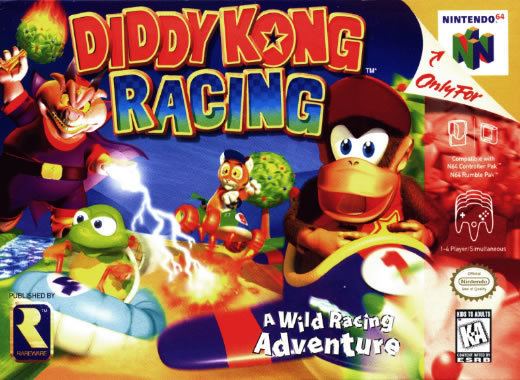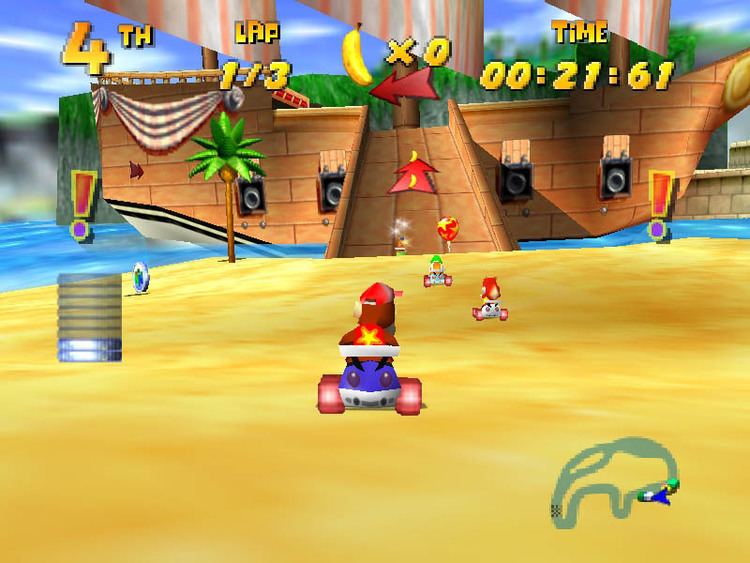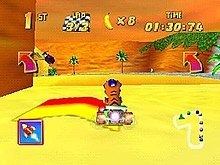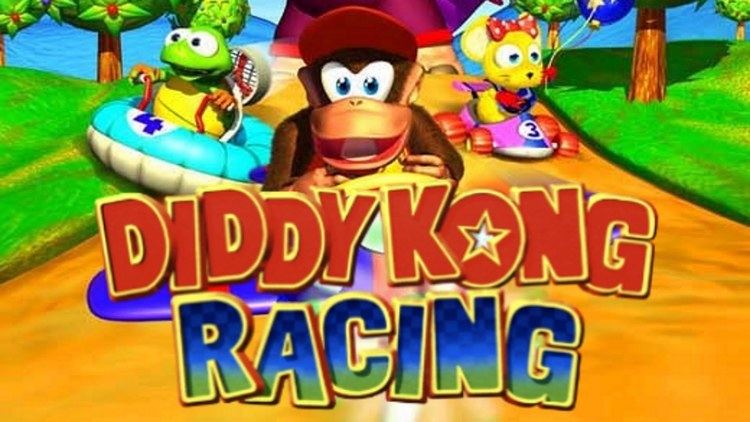7.8 /10 1 Votes7.8
6.6/10 GameSpot Distributor(s) Nintendo Producer(s) Chris Stamper Initial release date 14 November 1997 | 4.6/5 Emuparadise Director(s) Lee Schuneman Artist(s) Kevin Bayliss | |||||||||||||||||||||||||||||||||
 | ||||||||||||||||||||||||||||||||||
Release date(s) JP: 14 November 1997EU: 21 November 1997NA: 24 November 1997 Modes Single-player video game, Multiplayer video game Similar Donkey Kong games, Nintendo games, Racing video games | ||||||||||||||||||||||||||||||||||
Nintendo 64 longplay 026 diddy kong racing
Diddy Kong Racing is a racing video game developed and published by Rare for the Nintendo 64. It was first released on 14 November 1997 in Japan, 21 November 1997 in Europe and 24 November 1997 in North America. The game is set in "Timber's Island" and revolves around Diddy Kong and his friends' attempt to defeat the intergalactic pig-wizard antagonist, Wizpig, through winning a series of races. The player can take control of any of the featured characters throughout the game. Diddy Kong Racing features five worlds with four racetracks each, and the ability to drive a car, hovercraft, or pilot an aeroplane.
Contents
- Nintendo 64 longplay 026 diddy kong racing
- Nintendo 64 longplay diddy kong racing part 1
- Gameplay
- Plot
- Development
- Soundtrack
- Reception
- Sequels
- Remake
- References

Development of the game began after the release of Killer Instinct 2, and was intended to be a real-time strategy game known as "Wild Cartoon Kingdom" during early stages. As time progressed, the game shifted from a Walt Disney World-influenced racing game to a unique title named "Pro-Am 64", in which Nintendo had no involvement with. Due to the delays of Banjo-Kazooie, Rare felt that they needed a stronger intellectual property to attract a wider audience for a game scheduled to release before Christmas 1997, thus making the decision to revolve a game around the character of Diddy Kong.

Diddy Kong Racing received positive reviews from critics upon release. The graphics, audio and gameplay were the most praised aspects of the game, however minor criticism was directed at its repetitiveness. The game has sold 4.5 million copies since release and stands as the Nintendo 64's sixth best-selling game. A cancelled sequel, Donkey Kong Racing, was in development for the GameCube, however it was abandoned after Microsoft's purchase of Rare for £375 million in 2002. An enhanced remake for the Nintendo DS titled Diddy Kong Racing DS was released worldwide in 2007.

Nintendo 64 longplay diddy kong racing part 1
Gameplay

In Diddy Kong Racing, players can choose one of eight characters, who have access to three different vehicles: car, hovercraft and aeroplane. The car is an all-round vehicle, however it is slowest on surfaces such as sand and water. The hovercraft is designed for both sand and water areas but lacks in acceleration and manoeuvrability. The aeroplane is designed to access aerial areas; it is good at acceleration and manoeuvring, however it has the slowest speed. Each racetrack has a set of boosters known as "zippers" that temporarily boost the player's speed, as well as featuring regenerating balloons of various colours that provide power-ups. There are five different types of balloons: red, blue, green, yellow, and rainbow. Red balloons grant missiles to attack racers ahead, blue balloons grant a speed boost, yellow balloons grant shields to protect the player from attacks, green balloons grant deployable traps to delay other racers, and rainbow balloons grant a magnet ability that brings the player closer to the nearest racer. If multiple balloons of the same colour are picked up, the power-up will be upgraded to a more powerful version. A total of two upgrades are available for each balloon. Additionally, racetracks contain non-regenerating bananas that add to speed when they are picked up. A maximum of ten bananas will improve the speed but can also be obtained to prevent other players from gaining speed. If a racer gets hit, two bananas will be deducted.

In "Adventure Mode", players control the racer of their choice to progress through the story. Players begin on Timber's Island, which consists of five interconnected worlds; Dino Domain, Snowflake Mountain, Sherbet Island, Dragon Forest, and Future Fun Land. Each world contains four race tracks, an unlockable battle stage and a race against a boss character. Depending on the race track, players may have a choice of using either a car, hovercraft or aeroplane. Each race track contains boosters to racers that cross them, and balloons of various colours that provide power-ups to racers. If the player defeats Wizpig in Future Fun Land, obtains all amulet pieces and collect all of the gold medals, the player will be able to play in a mode called "Adventure 2". In this mode, all of the balloons change colour to platinum and the tracks are inverted from left to right. The game also features four battle modes which consist of two deathmatch maps, a capture-the-flag-style battle and a mode which involves opponents capturing eggs.
Plot

Timber the Tiger's parents go on holiday and leave their son in charge of the island they live on, leaving him and his friends to organise a race. Their enjoyment is derailed when an evil intergalactic pig-wizard named Wizpig arrives at Timber's Island and attempts to take it over after having conquered his own planet's racetracks. He turns the island's four guardians (Tricky the Triceratops, Bubbler the Octopus, Bluey the Walrus and Smokey the Dragon) into his henchmen. The only solution available to the island's inhabitants is to defeat Wizpig in an elaborate series of races that involve cars, hovercrafts, and aeroplanes. Drumstick the Rooster, the best racer on the island, failed this challenge and was transformed into a frog by Wizpig's black magic.
Timber recruits a team of eight racers: Diddy Kong, the first recruit; Conker the Squirrel and Banjo the Bear, recruited by Diddy; Krunch the Kremling, Diddy's enemy who follows after him; and Tiptup the Turtle, T.T. the Stopwatch, Pipsy the Mouse, and Bumper the Badger, inhabitants of Timber's island. Aided by Taj, an Indian elephant genie residing on the island, they eventually complete all of Wizpig's challenges and confront Wizpig himself to a race and defeat him. Shortly afterwards, Drumstick is turned back into a rooster, and Wizpig leaves for his home planet, Future Fun Land. Fearing that Wizpig would again attempt to invade Timber's Island, the islanders travel to Future Fun Land for a second challenge. When Wizpig loses the second race, the rocket he rides on malfunctions and launches him to the moon. However, an additional cutscene reveals Wizpig's spaceship flying through the sky, unscathed.
Development
Development of the game began after the release of Killer Instinct 2 for the Super Nintendo Entertainment System, in which a team was split into making Killer Instinct Gold for the Nintendo 64 and a new racing game for that console. At its first stage of development, Diddy Kong Racing was conceived as a real-time strategy game with a caveman/time-travel theme worked on by a team of four Rare members; Chris Stamper, Lee Musgrave, Rob Harrison and Lee Schuneman. During later stages of development, the game became influenced by Walt Disney World and soon evolved into an adventure game called Wild Cartoon Kingdom, in which Nintendo had no involvement with. In June 1997, the game was altered to Pro Am 64, an unrelated follow-up to the NES racing game R.C. Pro-Am. According to Schuneman, the Pro Am 64 project featured three-wheeled trikes in contrast to radio-controlled cars.
Due to Banjo-Kazooie being delayed until the summer of 1998, the team was adamant for a release of an AAA video game in time for Christmas 1997. Rare felt that Pro Am 64 did not have a strong enough intellectual property to capture the attention of consumers, and thus changed the licence to feature Diddy Kong. According to Musgrave, the decision to choose Diddy Kong rather than Donkey Kong was based on their own choice, a decision which Nintendo "enjoyed". Once the intellectual property was changed, the team were left to adapt the visual aesthetics of the game and packaging before it could be released. Musgrave stated that the ultimate goal of the game was to make it "run as fast" as Mario Kart 64, which proved difficult during development as the latter game utilised sprites of characters whereas Diddy Kong Racing used fully 3D models. Musgrave later attributed the success of the overall project due to the "small team" of 14 people who worked on it. In an October 2012 interview, Musgrave stated that Timber the Tiger would have been the main character of Pro Am 64 had the intellectual property for Diddy Kong Racing not been conceived. At least two of the characters who featured in Diddy Kong Racing, Banjo the Bear and Conker the Squirrel, went on to feature in their own series, the Banjo-Kazooie series and Conker series, respectively.
Soundtrack
The music for the game was composed by David Wise. The soundtrack was first released in Japan on 1 April 1998, with 42 tracks, a German version of the album was released in Europe with the same number of tracks. For its United States release only 16 tracks were featured. The disc itself was specially shaped in the form of Diddy Kong's head, which was unplayable in certain CD players.
Reception
The game received positive reviews from critics upon release. The Nintendo 64 version holds an aggregate score of 88% at both GameRankings and Metacritic, whereas the Nintendo DS remake received a score of 66% at GameRankings and a score of 63 at Metacritic, based on 39 reviews. Diddy Kong Racing sold approximately 4.5 million copies worldwide; which included 3.78 million copies sold in the United States and PAL regions, and 653,928 copies in Japan. It also stands as the Nintendo 64's sixth best-selling game.
The graphics and gameplay were the most praised aspects of the game. Scott McCall of AllGame asserted that Rare proved it was "the only developer" who offered no distance fog in their games. However, McCall acknowledged its only shortcoming was its "excessive" amount of clipping, although he admitted it was not "unbearable". Jeff Gerstmann of GameSpot stated that the game was a "pleasure to look at" and praised the detail of the tracks. Doug Perry of IGN heralded the visuals as the most "spectacular of its kind", and praised Rare's ability to master dynamic animation through enabling polygons to span larger surfaces without loss of framerate. Furthermore, Perry stated that the game's technical achievements were enough to leave "even the most critical Japanese gamer [to] look upon with smiling eyes". In a retrospective review, Andrew Donaldson of Nintendo Life stated that the game was visually "incredibly vibrant" and "captivating" for a game of the early Nintendo 64 era.
McCall praised the wide range of audio in the game, including its voice acting and soundtrack; he heralded the music as "interesting" and "fitting" to its race tracks, also considering it superior to that of Mario Kart 64. Although Gerstmann considered the gameplay to be similar to Mario Kart 64 and at times "repetitive", he praised the game's range of transportation and dynamics, which included utilising hovercrafts on water-based tracks and flying an aeroplane. Edge praised the adventure and progression aspect of the game, stating that the game's single-player mode is "everything Mario Kart 64 should have been." Perry felt that the vocals of characters in the game were "heartwarming" and "comical", while also stating that the music in each environment was "charming" and "dynamic". Donaldson criticised game's presentation as too "cutesy", especially in terms of the characters' voices. However, he praised the "upbeat" and "catchy" soundtrack, saying that each track had its own unique tune to suit the distinct environment.
Diddy Kong Racing won the Console Racing Game of the Year at the Academy of Interactive Arts & Sciences in 1998, beating Mario Kart 64, Moto Racer and NASCAR 98.
Sequels
After the release of Diddy Kong Racing, Rare began development on a sequel named Donkey Kong Racing for the GameCube, which featured Donkey Kong as the titular character. A pre-rendered CGI video of the game was shown at E3 2001, which displayed a parody of a scene from Star Wars: Return of the Jedi. According to Lee Musgrave, the game featured a unique mechanic which involved riding on animals rather than driving vehicles, in which the player could switch between different types of animals mid-race; larger animals could destroy obstacles whereas smaller ones allowed more manoeuvrability. Development of Donkey Kong Racing was cancelled when Nintendo turned down the opportunity to purchase its remaining 51 percent stake in Rare, and was eventually bought out by Microsoft for £375 million in 2002.
After the cancellation of Donkey Kong Racing, Rare created a prototype for the GameCube which expanded into an adventure game similar to the original setup of Diddy Kong Racing. Musgrave stated that the concept was "built from scratch" and featured a limited multiplayer version at one point. The unnamed concept was in development over 18 months and evolved from being an animal-orientated racing game to an open world game with Tamagotchi-style features, in which nurturing animals was a "key mechanic". During this time, the original concept for Donkey Kong Racing was reworked into Sabreman Stampede, which was eventually cancelled.
Aside from Donkey Kong Racing, another sequel to Diddy Kong Racing named Diddy Kong Pilot was planned for release on the Game Boy Advance. Originally announced alongside Donkey Kong Racing at E3 2001, the game eventually became Banjo-Pilot after Microsoft's acquisition of Rare. At the time of its announcement, the game featured the ability to play using a tilt function as well as a D-pad, and contained at least five available tracks.
Remake
Diddy Kong Racing was remade for the Nintendo DS as Diddy Kong Racing DS. Developed and published by Rare, it was released on 5 February 2007 in North America, and on 20 April 2007 in Europe. This version received enhanced visuals and framerate in addition to a touchscreen function. The DS version also features new modes which allows the player to create their own racetracks, customise their characters through recording voices and an online multiplayer function. The game was met with mixed reviews upon release, with critics asserting that the new additions were "gimmicky" and the touchscreen controls felt "horribly sensitive".
